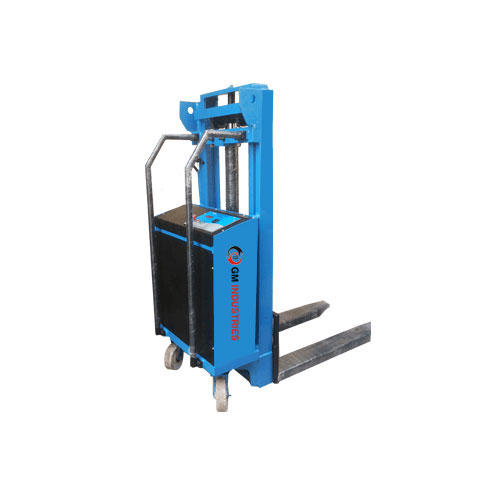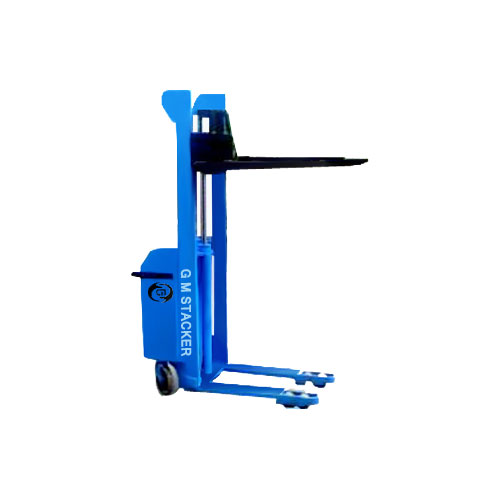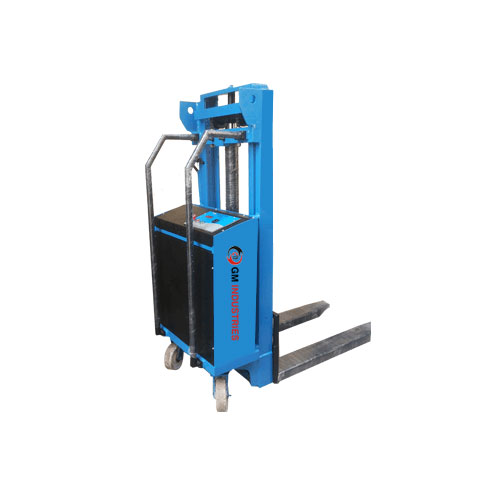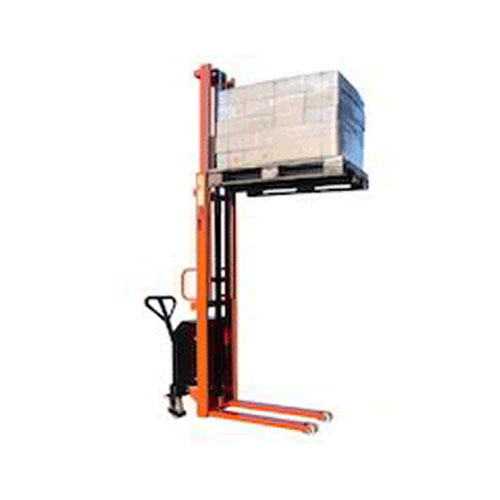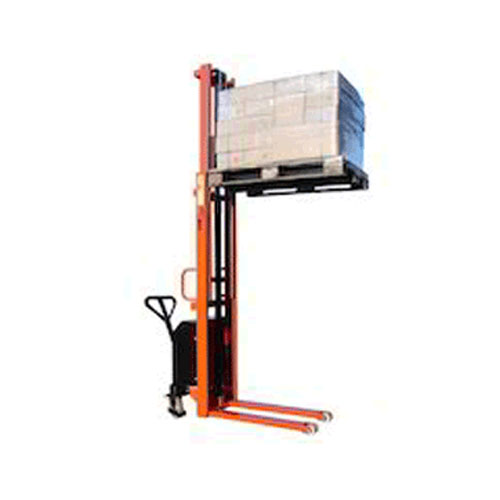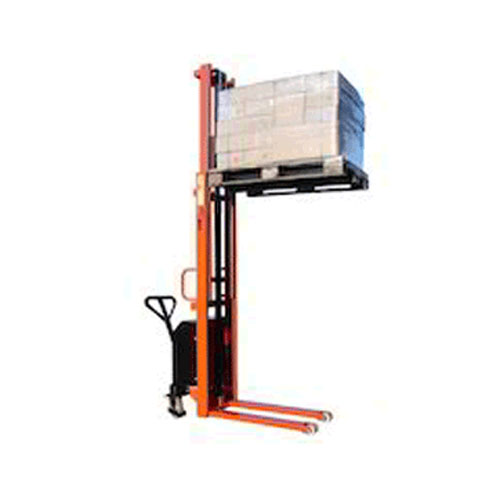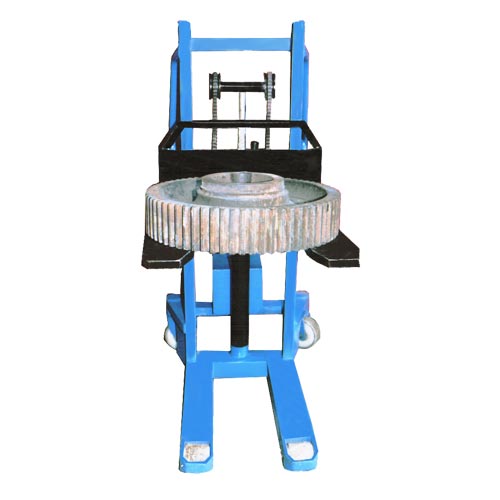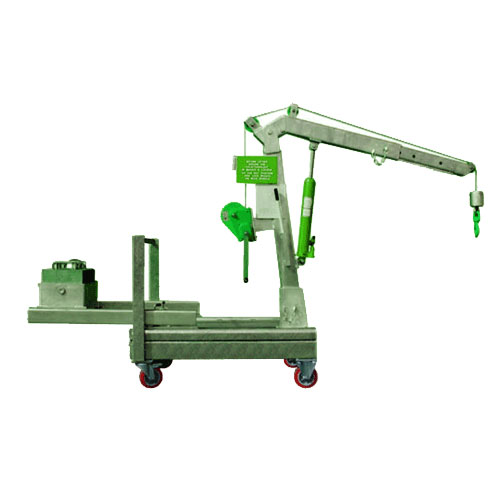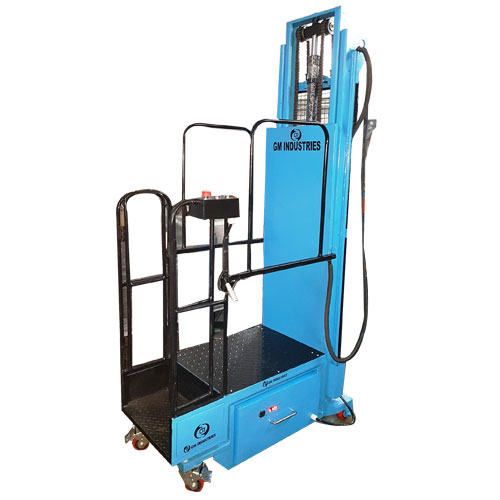Hydraulic Stackers
What is Hydraulic Stacker?
Hydraulic Stackers are devices designed for a safe and efficient way of handling materials in various industries such as distribution centers, logistics companies, and more. These stackers are made using the latest technology and high-quality materials. They come with several features that make them ideal for material handling purposes, such as a basic capacity range of 500kg – 2000kg, lift heights ranging from 1400mm – 2200mm, robust construction, and a pump assembly that includes a neutral position for controlled handling of loads.
The piston and cylinder of these stackers are hard chromed, and double-sealed high-pressure polyurethane seals are used to prevent leakage. They also have a lifting speed of 14mm/stroke, making them suitable for lifting over short distances.
Hydraulic Stackers find their applications in industries where lifting is the primary requirement, and the transport distance is short. GM Industries is a reputed hydraulic stacker manufacturer that specializes in manufacturing Hydraulic Stackers. As a prominent hydraulic stacker suppliers, we offer industry-best warranty of 1 year on their range of stackers.
Types of Hydraulic Stackers
There are several types of Hydraulic Stackers available for different material handling applications.
These are manually operated stackers designed for lifting and moving loads over short distances. They are ideal for small warehouses and workshops.
These stackers are designed for lifting and transporting bags of materials such as grains, cement, and fertilizers. They have a special attachment for securing bags during transportation.
These are electrically operated stackers that use an alternating current (AC) motor for lifting and moving loads. They are ideal for indoor material handling applications.
These stackers are similar to AC stackers but use a direct current (DC) motor. They are ideal for outdoor applications where AC power is not available.
These stackers are designed for handling pallets and other heavy loads. They are electrically operated and can lift loads up to several feet off the ground.
These stackers are manually operated and are designed for lifting and transporting loads over short distances. They are ideal for small warehouses and workshops.
These stackers have a counterweight design that provides stability during lifting and transporting loads. They are ideal for handling long and bulky loads.
These stackers are designed for lifting and transporting loads over long distances. They have a higher lifting capacity than other types of stackers and are ideal for large warehouses and industrial applications.
Hydraulic Stacker Price List
The Hydraulic Stacker Price offered by Hydraulic Stacker Manufacturers is listed below: –
| Product Range | Price |
| Hydraulic Hand Stacker | ₹ 1.85 Lakhs / Unit |
| Hydraulic Bag Stacker | ₹ 2 Lakhs / Unit |
| Hydraulic AC Stackers | ₹ 1.65 Lakh / Unit |
| Hydraulic DC Stackers | ₹ 1.65 Lakh / Unit |
| Electric Pallet Stackers | ₹ 1.9 Lakh / Unit |
| Manual Stacker | ₹ 35000 / Unit |
| Counter Balance Stacker | ₹ 60000 / Unit |
| Lift Stacker | ₹ 45000 / Unit |
(Prices shown above are provisional prices and may change due to different market conditions and requirements.)
For more information on any of our high quality products or getting accurate prices contact GM Industries at
Call Us
+(91)-9820533489 / 7738562224
Enquiry Form
Submit
How Does a Hydraulic Stacker Work?
The working principle of a Hydraulic Stacker is based on the principle of hydraulic power. These stackers use hydraulic cylinders, which are powered by pressurized hydraulic fluid to lift and move loads.
The hydraulic system consists of a hydraulic pump, a hydraulic cylinder, and a control valve. The pump generates high-pressure hydraulic fluid that is sent to the cylinder through a control valve. The control valve regulates the flow of hydraulic fluid to the cylinder, controlling the direction and speed of the movement of the hydraulic ram.
The hydraulic cylinder is made up of a piston and a cylinder that are connected by a rod. When the hydraulic fluid is pumped into the cylinder, it exerts pressure on the piston, causing it to move upwards. This upward movement of the piston lifts the load that is placed on the lifting platform of the stacker.
To lower the load, the hydraulic fluid is released from the cylinder and sent back to the hydraulic pump through the control valve. This causes the hydraulic ram to move downwards, bringing the load down to the ground.
The hydraulic system of a Hydraulic Stacker is designed to provide a smooth and controlled lifting and lowering operation, ensuring the safe and efficient handling of loads.
Advantages of Hydraulic Stacker
Hydraulic Stackers have several advantages that make them an ideal choice for material handling applications. Some of the main advantages of Hydraulic Stackers include:
Efficient lifting
Hydraulic Stackers use hydraulic power to lift heavy loads efficiently, reducing the manual effort required for lifting and moving loads.
Safe operation
Hydraulic Stackers have a smooth and controlled lifting and lowering operation, ensuring the safe handling of loads and reducing the risk of accidents.
Easy to operate
Hydraulic Stackers are designed for easy operation, with simple controls that can be easily understood and operated by anyone.
Versatile
Hydraulic Stackers are available in different types and sizes, making them suitable for a wide range of material handling applications.
Cost-effective
Hydraulic Stackers are a cost-effective solution for material handling, as they require less maintenance and have a longer lifespan compared to other types of stackers.
Saves space
Hydraulic Stackers are designed to be compact and space-saving, making them ideal for use in small warehouses and workshops.
Improves productivity
By reducing the manual effort required for lifting and moving loads, Hydraulic Stackers can improve productivity and reduce labour costs.
Overall, Hydraulic Stackers are a reliable and efficient solution for material handling applications, providing a range of benefits that can help businesses improve their operations and increase their productivity.
Applications of Hydraulic Stacker
Hydraulic Stackers are versatile material handling equipment that can be used across various industries for different applications. Here are some of the applications of Hydraulic Stackers in different industries:
- Warehousing and logistics: Hydraulic Stackers are widely used in warehouses and logistics industries for lifting and moving loads over short distances. They are ideal for loading and unloading trucks, stacking pallets, and transporting goods within the warehouse.
- Manufacturing: In the manufacturing industry, Hydraulic Stackers are used for lifting and positioning heavy materials and equipment. They are also used for loading and unloading materials from production lines.
- Construction: Hydraulic Stackers are used in the construction industry for lifting and moving materials such as bricks, blocks, and cement bags. They are also used for positioning heavy equipment and tools at construction sites.
- Agriculture: Hydraulic Stackers are used in the agriculture industry for lifting and transporting bags of fertilizers, grains, and other materials. They are also used for loading and unloading farming equipment and tools.
- Retail: Hydraulic Stackers are used in the retail industry for moving and stacking goods in storage areas and display shelves. They are also used for loading and unloading trucks and for transporting goods within the store.
- Healthcare: In the healthcare industry, Hydraulic Stackers are used for lifting and moving medical equipment, hospital beds, and other heavy loads.
Overall, Hydraulic Stackers are used in various industries for different material handling applications. They are a versatile and reliable solution for lifting and moving loads safely and efficiently, and can help businesses improve their operations and increase their productivity.
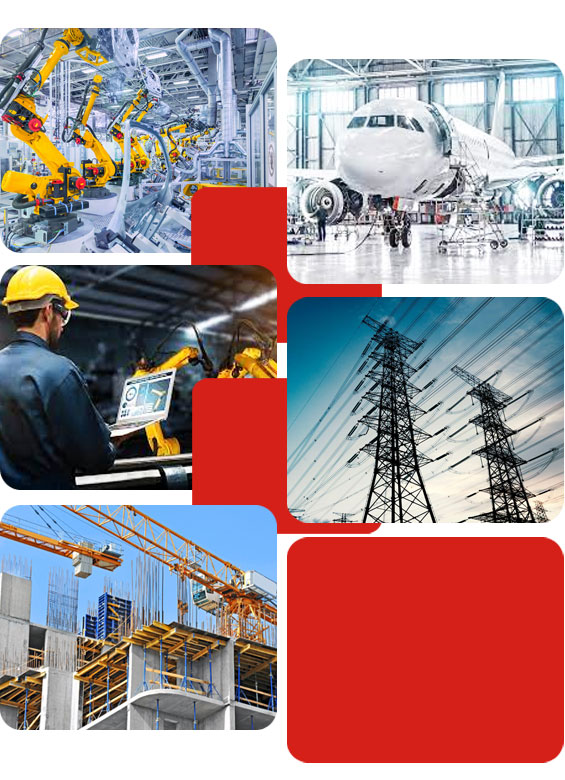
How do I choose a Hydraulic Stacker?
If you are looking for a reliable and efficient Hydraulic Stacker for your material handling applications, GM Industries can help you find the right solution. With our range of high-quality Hydraulic Stackers, including Hand Stackers, Bag Stackers, AC/DC Stackers, and Electric Pallet Stackers, they offer a versatile and cost-effective solution for lifting and moving loads in different industries. Their stackers are designed with the latest technology and qualitative material, ensuring safe and efficient handling of loads. As a leading hydraulic stacker manufacturers in Mumbai GM Industries also offers industry-best warranties, providing their customers with peace of mind and a guarantee of quality. With their expertise in the material handling industry, GM Industries can help you find the right Hydraulic Stacker for your specific application, ensuring that you have the equipment you need to improve your operations and increase your productivity.
Frequently Asked Questions
A Hydraulic Stacker is a material handling equipment used for lifting and moving heavy loads in various industries.
A Hydraulic Stacker works by using hydraulic power to lift and lower heavy loads. The hydraulic pump generates pressure that moves the hydraulic cylinder, which in turn lifts or lowers the load.
The types of Hydraulic Stackers include Hand Stackers, Bag Stackers, AC/DC Stackers, Electric Pallet Stackers, Manual Stackers, Counterbalanced Stackers, and Lift Stackers.
The advantages of using a Hydraulic Stacker include efficient lifting, safe operation, ease of use, versatility, cost-effectiveness, space-saving design, and improved productivity.
Hydraulic Stackers are used in various industries for lifting and moving loads, including warehousing and logistics, manufacturing, construction, agriculture, retail, and healthcare.
The lifting capacity of a Hydraulic Stacker ranges from 500 kg to 2000kg.
The lifting height of a Hydraulic Stacker varies depending on the type and model, but typically ranges from 1400mm to 2200mm.
The lifting speed of a Hydraulic Stacker varies depending on the type and model, but typically ranges from 10mm to 14mm per stroke.
The warranty period for a Hydraulic Stacker varies depending on the manufacturer and model, but typically ranges from 1 year to 2 years.
Yes, Hydraulic Stackers can be used for outdoor applications, but it is important to choose a stacker that is suitable for outdoor use and can withstand the elements.
The maintenance requirements for a Hydraulic Stacker include regular inspection, cleaning, lubrication, and replacement of worn-out parts.
To choose the right Hydraulic Stacker for your application, you need to consider factors such as the weight and size of the load, the lifting height required, the operating environment, and the frequency of use.
Yes, Hydraulic Stackers can be customized to meet specific requirements such as lifting capacity, lifting height, and fork size.
Yes, Hydraulic Stackers are safe to use if operated correctly and maintained properly. It is important to follow the manufacturer’s instructions and safety guidelines when using a Hydraulic Stacker.
No, Hydraulic Stackers should not be used to lift people. They are designed for lifting and moving loads only.
The main difference between an AC Stacker and a DC Stacker is the type of motor used. An AC Stacker uses an AC motor, while a DC Stacker uses a DC motor.
Yes, Hydraulic Stackers can be used to lift fragile or delicate loads, but it is important to choose a stacker with the appropriate lifting capacity and to handle the load carefully.
